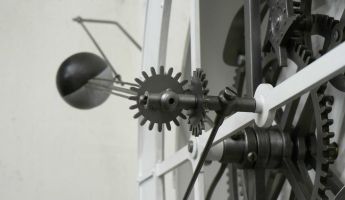
Original solution of moon phases
Originally, the Moon sphere on the clock was rotated by a toothed angle 1/1 transmission from the leading bar of the Sun. The solution has not been preserved. We can imagine it based on the cabinet model of the clock constructed for the Habsburg court in the 1670’s (deposited in the Kunsthistorisches Museum in Vienna) or a similar solution of certain modern interior clock. We get back to both the mentioned clocks later.
This system, however, had a significant fault in indication of the moon phase. The deviation varied depending on the season of the year during the synodic moon (position of the Sun within the ecliptic) and the position of the Moon towards the Sun. The deviation was largest at full moon around the vernal or autumnal equinox, when it fluctuated by 0–47° of the turn of the Moon sphere in the course of the month (which means almost 4-day difference of the moon phase). Due to its nonlinear progression, the deviation meant a delay (in the autumn) or an advance (in the spring) of 3.3 days at equinoxes. In principle, the deviation is caused by the fact that the wheelwork driving the Moon sphere is at the centre of the ecliptic, which is quite distant from the centre of the dial.

In the picture, the full moon for the autumnal equinox is, due to the transmission from the centre of the ecliptic, set in position 2, which is the moment of the apparent opposition of the Moon and the Sun, in reference to the centre of the ecliptic ring. However, the full moon comes in the moment of the opposition in reference to the centre of the dial, i. e. in position 1. In other words: in position 2, the Moon arm is 3.3 days after the full moon – angle 41°. In position 1, the Sun and Moon arms are in line. The Moon sphere should be in the phase of full moon but it is 47° ahead of it and it will reach the full moon in 3.3 days, after the Moon arm turns by 41°.
Na obrázku v době podzimní rovnodennosti je díky převodu ze středu Ekliptiky nastaven úplněk v poloze 2, tedy v okamžiku zdánlivé opozice Měsíce ke Slunci vzhledem ke středu kola Ekliptiky. Úplněk ovšem nastává v okamžiku opozice vzhledem k středu ciferníku, tedy v poloze 1. Jinak řečeno. V poloze 2 je měsíční rafie již 3,3 dny po úplňku - úhel 41°. V poloze 1 je rafie Slunce a Měsíce v přímce. Koule Měsíce by měla být v úplňku, ale je 47° před úplňkem, kterého dosáhne za 3,3 dne po otočení měsíční rafie o 41°.
This was almost certainly the reason why somebody constructed the ingenious device that is installed on the clock today. The rotation of the Moon around its axis is ensured by a doublethread worm rotating in a frame inside the Moon sphere synchronically with the Moon arm. The rotation of the worm is ensured by the weight, which is attached eccentrically to it and this maintains the constant position of the worm towards the direction of gravity. For more information see the dedicated page.
Text and illustration: Petr Skála


